Features, properties and application of cubic zirconia

Cubic zirconia is an artificially grown crystal and looks like a cut diamond. It is actively used in the production of jewelry and is appreciated by lovers of exquisite jewelry. The high popularity of the stone is due to its strong resemblance to a diamond and a fairly affordable price. In addition to jewelers, cubic zirconia is widely used by manufacturers of optical devices, as well as dentists, who use it as one of the main materials for dental spraying.

Origin story
The question of whether cubic zirconia is a precious stone worries many, and in order to answer it, you need to familiarize yourself with the history of its creation and its chemical composition. So, cubic zirconia was developed in the Soviet Union back in 1968 with the participation of scientists from the Physics Institute of the Academy of Sciences named after V.I. Lebedev, FIAN for short. It was this abbreviation that gave the name to the new crystal obtained by physicists as a result of work on improving the refraction of a laser beam.
The result of the scientists' labors was a beautiful stone that very naturally imitates a diamond and later became one of the most popular artificially created crystals used in jewelry.



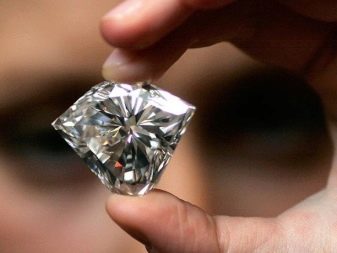
Due to the unnatural origin, cubic zirconia is not a precious stone, but in appearance it is not much inferior to it.
However, the strong resemblance to the precious mineral has spawned numerous fraudulent schemes and has caused a rather biased attitude towards cubic zirconia in the jewelry market.So, in the early 70s, the appearance of a penny copy of a diamond provoked panic among foreign manufacturers and a negative attitude towards the development of Soviet scientists, which, in turn, led to great chagrin of the creators, who developed the crystal for completely different purposes.
But over time, the hype around the crystal died down and large foreign companies themselves began to produce artificial diamonds.

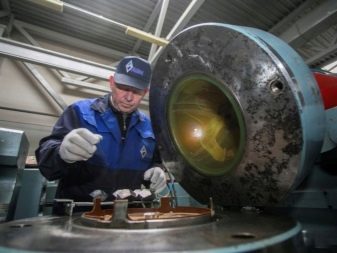


Therefore, if the marking on a piece of jewelry says that it is made using jewalite, zirconite or daimonskway, then this means that the same cubic zirconia was taken as decoration, only of foreign production.
Since the beginning of the 90s, the synthesized mineral has become very popular, in some years the total weight of all crystals produced in the world reached 50 million carats. Today, production volumes are steadily growing, providing true connoisseurs of beauty with exquisite and inexpensive products, which in their appearance are in no way inferior to products with real diamonds.
In addition to diamonds, cubic zirconia is often mistaken for Swarovski crystals, which are a patented type of crystal and have nothing to do with the development of Soviet scientists. And thanks to the possibility of dyeing in different colors, the stone successfully replaces topaz, sapphires and garnets. Moreover, many jewelry lovers who know a lot about this matter deliberately choose cubic zirconia. This is due to the technology of processing crystals and the fact that artificial stones are suitable for applying any, even the most complex and intricate cut, while natural minerals are processed much more difficult and cannot boast of a wide variety of ornate shapes.
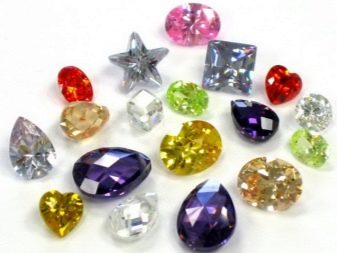

Description
Cubic zirconia is an unstable high-temperature cubic modification of zirconium dioxide ZrO2 and contains additives of manganese, calcium and yttrium oxides. Due to the refractive index of light, which is 2.15-2.25 units, and close to that of diamond, equal to 2.417-2.419 units, cubic zirconia is very difficult to visually distinguish from a precious mineral.
The crystal does not have a stable chemical formula, which is explained by the content of certain additives in its composition, which are used depending on the properties that are planned to be obtained. The stone has a diamond luster, uneven fracture and is characterized by a lack of cleavage.


Zirconia itself is colorless, therefore to give the crystals the desired color, they are dyed using transition and rare earth elements. This happens in the process of making a mineral, the crystallization of which is carried out in laboratory conditions using the technology of cooling melts, in which the crystallization rate is from 8 to 10 mm / h.
As dyes, oxides of such metals are used as cerium, which gives cubic zirconia yellow, red and orange shades, chromium, which gives a deep green color, neodymium and erbium, which color crystals in purple and pink tones, respectively, and titanium, which gives a golden brown hue at the output. ...


Properties
Cubic zirconia is also similar to a diamond in its physical properties. For example, the hardness of an artificial crystal on the Mohs scale varies from 7.5 to 8.5 units, while the same indicator for a diamond is 10 units.
The density of stones also does not vary too much, and is 3.5 g / cm3 for diamond and about 6.5 g / cm3 for cubic zirconia. As for the index of refraction of light, both a diamond and its non-precious counterpart have almost the same index and is 2.4 and 2.25 units, respectively. On the other hand, the weight of an artificial crystal differs significantly from the weight of a diamond and exceeds it by almost 60%.

As for the magical properties of cubic zirconia, due to its laboratory origin, they are, in principle, absent.Although some astrologers and specialists in working with energies believe that such a crystal also plays a certain role and influences the fate and well-being of a person.
Views
The high popularity of cubic zirconia and its ability to masterly imitate a number of precious expensive minerals is due to the ability of the crystal to be colored in different shades and good color fastness. Black and green stones are in great demand. Next in popularity is blue, as an option - blue, red, pink and purple, which also look great in jewelry and impress owners with an even and deep shine.
Crystals of lilac color look very unusual, as well as golden brown and purple. By the way, when the stone is heated to very high temperatures, it loses its transparency and becomes similar to white pearls or black diamonds.


Moreover, thanks to the use of modern technologies, specialists have learned to synthesize a stone with a color change - an effect characteristic of the rare and expensive alexandrite. Also crystals of cubic zirconia are turquoise, cognac and pale yellow shades, and in total, scientists have learned to produce cubic zirconia in more than 20 colors.
The most unusual and expensive minerals are considered to be blue-green spectrum minerals, which are currently produced only at enterprises in Russia and the United States. Jewelry with cubic zirconia of this color looks very expensive and noble and is very popular with fashionistas. However, it should be noted that Scientists have not yet been able to obtain a natural emerald hue, and all attempts end in the production of crystals that are more likely to resemble chrysolite in color.



Considering the shades of cubic zirconia, one cannot fail to note the fact that many of a wide range of colors have never existed in nature. This applies to lilac, violet and crimson shades, which quickly became fashionable and became in high demand among buyers.
Application
Due to its many positive properties and relatively low production costs, cubic zirconia is actively used in various fields of human activity. So, there is an opinion about the healing properties of an artificial mineral, which, according to such statements, increases the general tone of the body, improves cellular metabolism and promotes the positive work of various organs. However, there are many skeptics on this issue.


So, experts in lithotherapy - stone treatment, consider cubic zirconia absolutely useless from the point of view of medicinal properties of a crystal and are confident in its inability to have any significant effect on human organs.
In addition to being used in jewelry, cubic zirconia is often chosen as a raw material in the production of microscalpels. This is due to the high hardness of the material, its heat resistance and low cost. In addition, the crystal is used as one of the components in ceramic spraying in the dental industry.


However, the greatest number of disputes is caused by the advisability of using cubic zirconia in magic... The main difference between synthesized crystals and natural stones is their energetic "sterility". Artificial stones do not carry any energy - neither negatively charged nor positive. However, many energy specialists argue that due to the absence of cracks and defects, and also due to the absolute transparency of the crystals, cubic zirconia can be considered as the purest vessel that is filled with the energy of its owner.

Therefore, the magical properties that the crystal will be endowed with completely depend on the personality and character of the person who will wear it.
So, one of the important characteristics of cubic zirconia is considered his ability to "remember" a series of events, thoughts and emotions, which is why he can well be used as a talisman. The main thing in this matter is to give the stone the right message and endow it with extremely positive energy. For this, jewelry with a stone is recommended to be worn when vital events occur, in moments of great emotional uplift, a state of happiness and peace of mind.


During the "charging" of the stone with positive energy, it should not be given into the hands of other people, even the closest and most benevolent ones.
If cubic zirconia was donated and was with another person for some time, then it must be placed in a container with clean spring water or held over a flame. It is believed that in this way it is possible to cleanse the stone of foreign energy and make it suitable for further use as an amulet or amulet.


By the way, the most common amulets are horseshoes, spoons, Tibetan knots of happiness and a four-leaf clover.
When using cubic zirconia as decoration an important issue for many is its compatibility with other precious and semi-precious stones. In this regard, it is necessary to reassure all the owners of this beautiful stone: the crystal is combined with absolutely all natural minerals, moreover, it is believed that it is even capable of enhancing their natural energetic effect and strength.
Visually, the crystal looks very harmoniously with topaz, amethyst, citrine and pomegranate, and only emphasizes their bright radiance and nobility. As for the metal setting, cubic zirconia looks great in gold, silver and platinum frames, favorably setting off the central gem and giving the piece a high artistic value.
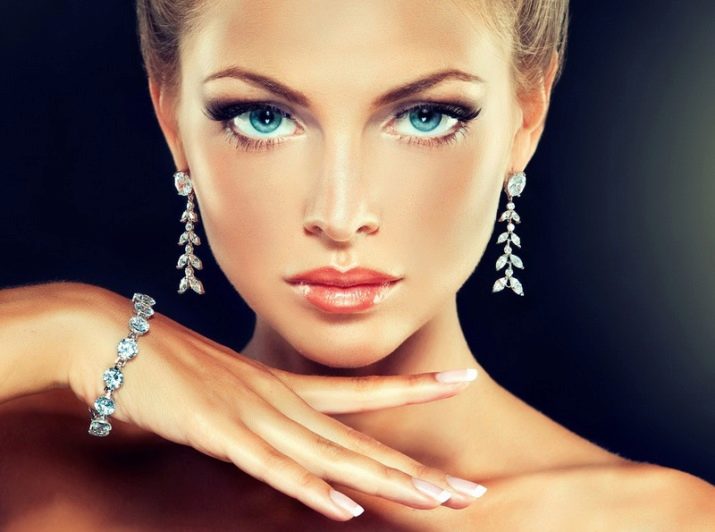





Who is it suitable for?
People who work with energies are sure that cubic zirconia suits absolutely everyone, the main thing is that before putting on the jewelry, the crystal is absolutely "clean", and subsequently correctly "charged". Astrologers hold a slightly different opinion, who believe that for each sign of the zodiac there is its own color of cubic zirconia, which determines the usefulness of the stone for a particular person.
So, for the signs of the fire element - Aries, Leo and Sagittarius, it is recommended to acquire yellow, orange and red crystals, which most accurately reflect their energy potential. The signs of the earth element - Virgo, Taurus and Capricorns, it is advisable to opt for light yellow, cognac or golden cubic zirconias, reminiscent of the earth in their shade.
Air signs - Aquarius, Libra and Gemini, it is recommended to purchase transparent or pale pink cubic zirconia. And for the water signs - Cancer, Scorpio and Pisces, blue and blue shades are best suited.
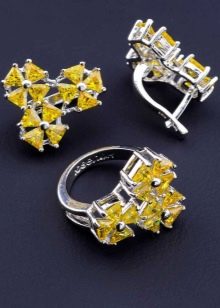


Moreover, astrologers are sure that cubic zirconia affects the life of each zodiac sign in different ways and give a number of recommendations on this score.
- Aquarius the stone will help to achieve success in communication with people and learning. And for girls born under this sign, it is advisable to purchase cubic zirconia in a platinum or silver frame.
- Pisces a small ring or earrings with cubic zirconia will help protect against damage and the evil eye. Moreover, the crystal is able to attract money, and its owner has a chance to develop good intuition.
- Aries by their nature, they are often too hot-tempered, and cubic zirconia is able to moderate their ardor a little and make its owner a little calmer. Moreover, the crystal has the most positive effect on the intelligence of Aries and stimulates his brain activity.
- Taurusthose with a gentle disposition and docile character will gain confidence in their abilities and become a little more decisive. Moreover, cubic zirconia often acts as a "charger" for this sign, feeding it with accumulated energy during periods when it is necessary.
- Gemini wearing cubic zirconia will help get rid of excessive talkativeness and give them a working spirit. The most suitable crystals for them are black and transparent specimens.Moreover, purple cubic zirconia often acts as an everyday substitute for amethyst - Gemini's stone.
- Cancer wearing a fake diamond will give confidence on the love front and serve as an excellent stimulator of mental alertness. Moreover, Cancer is the most sensitive sign of the zodiac and more often than others need a powerful energy supply coming from cubic zirconia.
- Lions, like all fire signs, are often subject to short bursts of anger, which cubic zirconia helps to smooth out. People of this sign are encouraged to wear jewelry with a crystal in a gold setting, as well as combine them with rubies and garnets.
- Virgin, as one of the most difficult signs of the Zodiac, they can wear jewelry with cubic zirconia to soften the sharp corners of their character and emphasize their positive qualities - pragmatism and accuracy. Green, white and lavender stones are well suited for such people, which will help them to reveal the insincerity of a partner in time and not make a mistake in his choice.
- Libra wearing products with cubic zirkonia will help calm the nervous system and maintain peace of mind even in the most difficult situations. Moreover, the crystal helps to improve mood, reveal true potential and ensure success on the love front. The exception is made by persons born from 14 to 23 October, since, on the recommendation of astrologers, they should wear only natural stones.
- Scorpions, The patron of which Mars is considered, it is necessary to wear dark red cubic zirconia, which will help them get rid of the negative accumulated during the day and will serve as a deterrent to their excessive emotionality. Moreover, if there is an opportunity to purchase a crystal with a color-changing effect, which has a very strong energy, then this will be the best option for people of this sign. Stones help Scorpios to achieve success in love, and also have a beneficial effect on the psycho-emotional background.
- Sagittarius wearing cubic zirconia will help unleash creativity and will help open up new horizons. In addition, the crystal helps to stimulate brain activity and aids in learning.
- Capricorn jewelry with cubic zirconia will help restore peace in the family and achieve mutual understanding with others. It is also believed that wearing a crystal will help you cope with financial difficulties and resolve old problems.


How to distinguish from glass?
Distinguishing cubic zirconia from glass is quite simple; you do not need to be a jeweler or conduct a chemical analysis of the material. To do this, you just need to take a good look at the appearance of the crystal and pay attention to its brilliance. So, in glass it will be dimmer, while cubic zirconia has a beautiful and even shine, comparable only to the deep shine of a natural diamond.
Another criterion for difference is hardness. Glass "stones" are much softer than cubic zirconia and crumble well.

Differences from a diamond
It is also easy to distinguish a natural diamond from cubic zirconia, and this can be done by a number of external signs. So, the edges of the cut of an artificial crystal are quite rounded, while the diamond cut has clear and pointed edges. Therefore, when a sharp edge is drawn along a mirror surface, cubic zirconia will only slightly scratch it, while a diamond will simply cut it. Moreover, due to the increased density cubic zirconia is much heavier than diamond, and under the influence of ultraviolet rays is less transparent than diamond.
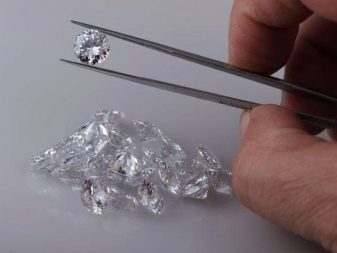

Another sure way to distinguish a natural stone from an artificial one is to check the temperature of the mineral after it has been in your hands for a short time. At the same time, the diamond will remain cold to the touch, while the cubic zirconia will heat up. Also, with prolonged wear, the artificial mineral quickly fades and requires cleaning, while the diamond can be worn indefinitely and will look like new.
And the last difference is this: breathing on cubic zirconia leads to the formation of condensation, but this does not happen with a diamond.

As you can see, diamond and cubic zirkonia differ more in physical properties than in appearance, and therefore it is almost impossible to recognize an artificially synthesized material upon visual examination.
Care rules
Caring for cubic zirconia is quite simple and includes a number of mandatory procedures.
- From time to time, it is recommended to polish the crystal with a soft cloth, regardless of whether the product has lost its luster or not, and also to wipe it with a damp cloth.
- In case of severe tarnishing of the artificial mineral, it is necessary to prepare a warm soapy solution and thoroughly clean the product.
- Cubic zirconia does not tolerate the effects of household chemicals, including chlorine and cosmetics, so their contact with the product is highly undesirable.
- Like any other artificially synthesized stone, cubic zirconia cannot stand being dropped on a hard surface.
- When doing homework, it is better to remove the ring with cubic zirconia.
- Storage of products should be carried out in a closed case. This will protect them from accidental damage and extend their service life.




Stone cost
The average cost of a stone weighing three carats is about 600-800 rubles per piece. However, the price of crystals depends on many factors, such as color, type of cut, size of the crystal, quality of the frame and the manufacturer of the jewelry.
- So, the most expensive are stones imitating ruby, sapphire, emerald or blue topaz. The high cost of the latter is explained by the complexity of the synthesis of blue and green shades, therefore the price for such crystals is 2-3 times higher than the average.
- The method of cutting also affects the final cost of a piece of jewelry with cubic zirconia, and in this case it is completely determined by the jeweler. The stone can be shaped into shapes of varying complexity - drops, hearts, or polygons with different numbers of faces.
- A variety of materials are used as a frame for cubic zirconia, the most expensive of which is gold. For example, a not too wide ring, decorated with a large crystal of cubic zirconia, will cost 6 thousand rubles, while a product of the same size, but encrusted with a scattering of small pebbles, will cost already 9-12 thousand rubles, and a wide solid ring with imitation ruby or alexandrite can cost 20 thousand or more.
Silver jewelry with cubic zirconia is somewhat cheaper. So, a not too wide ring, decorated with a medium-sized stone, will cost from 1.5 to 4.5 thousand rubles.

How cubic zirconia is made, see the next video.








